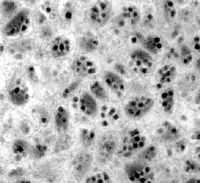
Photo from wikipedia
Ontsira mellipes Ashmead is a gregarious larval ectoparasitoid of woodboring cerambycids. It is native to North America but can readily attack the exotic Asian longhorned beetle, Anoplophora glabripennis (Motschulsky). This… Click to show full abstract
Ontsira mellipes Ashmead is a gregarious larval ectoparasitoid of woodboring cerambycids. It is native to North America but can readily attack the exotic Asian longhorned beetle, Anoplophora glabripennis (Motschulsky). This study aimed to develop an efficient rearing system for this parasitoid, as a potential novel association biocontrol agent for the beetle, by investigating the effects of different densities of host (two, three, or four larvae) and parasitoid (one, two, three, four, five, six, seven, and eight female wasps) on Ontsira's parasitization efficiency and reproductive outcomes. Results showed that overall parasitism and total numbers of parasitized hosts or progeny produced increased with host and/or parasitoid densities, but the number of parasitized hosts or progeny produced per female parasitoid decreased with parasitoid density at each given host density. Nonlinear regression indicated a consistent pattern of mutual interference as parasitoid density increased. Additional experiments showed that superparasitism (indirect interference) did not occur probably because the parasitoid detects hosts through vibration cues from host feeding and attacked (thus paralyzed) hosts are no longer detectable. Thus, the interference probably results from direct or exploitative competition. Interestingly, female parasitoids responded to increased parasitoid density with a significant increase in clutch size. Overall, per capita parasitization efficiency or reproductive outcomes were optimized at a low parasitoid-host ratio but with large group size of hosts and parasitoids. Therefore, an optimal combination of exposing three or four parasitoids to four hosts is proposed for efficient mass-rearing of this parasitoid.
Journal Title: Environmental entomology
Year Published: 2020
Link to full text (if available)
Share on Social Media: Sign Up to like & get
recommendations!